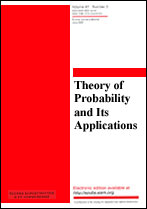|
|
Teoriya Veroyatnostei i ee Primeneniya, 1975, Volume 20, Issue 1, Pages 144–150
(Mi tvp2998)
|
 |
|
 |
This article is cited in 2 scientific papers (total in 2 papers)
Short Communications
Excessive functions connected with a regular Markov split process
S. E. Kuznetsov
Moscow
Abstract:
We start from an arbitrary (non-homogeneous) Markov process ($x_t$, $\mathbf P$) with the following property: its two-dimensional distributions are absolutely continuous with respect to the product of the corresponding one-dimensional distributions. We construct two regularizations of this process, denoted by ($x_{t+}$, $\mathbf P$) and ($x_{t-}$, $\mathbf P$). These regularizations have different state spaces and a common sample space. In a certain sense, we may consider $x_{t+}$ as the right limit of $x_{t-}$ and $x_{t-}$ as the left limit of $x_{t+}$. We may construct the traditional pair of dual processes by reversion of time for the process $x_{t-}$, but this reversion is not necessary. Dynkin proved in [2] that the pair $(x_{t-},x_{t+})$ may be considered as a Markov process with split time (split process). Regularity properties of this process do not depend on the direction of time. We call this process “regular split process”.
The class of excessive functions corresponds to every Markov process. We say, that a non-negative function $h^t(x)$ is an excessive function, if $P_t^sh^t(x)\uparrow h^s(x)$ as $t\downarrow s$. (here $P_t^s$ are operators corresponding to the transition function). This definition may be naturally transferred to split processes.
We investigate the behaviour of excessive functions along trajectories of a regular split process. For “good” processes the value $h^t(x_t)$ of an excessive function defines a nonnegative right-continuous supermartingale. On the other hand, every function $h$ with the above property is equal to a certain excessive function everywhere, except for some set inaccessible for the process. In case of a regular split process, these propositions are in general, not true. However, it may be interesting to study such functions values of which along the trajectories define a non-negative supermartingale continuous in the topology of the split line. We call such functions “superharmonic functions”.
We consider relations between the classes of excessive and superharmonic functions and study also transformations of a split process.
Received: 10.09.1974
Citation:
S. E. Kuznetsov, “Excessive functions connected with a regular Markov split process”, Teor. Veroyatnost. i Primenen., 20:1 (1975), 144–150; Theory Probab. Appl., 20:1 (1975), 145–150
Linking options:
https://www.mathnet.ru/eng/tvp2998 https://www.mathnet.ru/eng/tvp/v20/i1/p144
|


|




 Contact us:
Contact us: Terms of Use
Terms of Use
 Registration to the website
Registration to the website Logotypes
Logotypes








 Citation in format
Citation in format 
